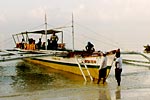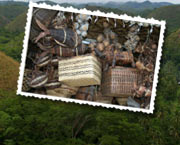Watching Dolphins on Bohol
IJsselstein, Monday, 28 October 2002 (updated: Wednesday, 6 December 2006)
Bohol, an island in the middle of the Visayas, the large group of islands in the middle of the Philippines, is an excellent tourist destination, as it has much to offer to visitor. Long stretches of white beach to laze around, world class diving spots with some of the best coral reefs in the country, the amazing and unique Chocolate Hills, which you will have to see to believe, the shy and tiny tarsier, one of the smallest primates in the world, a rich

|
| A long-snouted spinner dolphin, Stenella longirostris. |
One of the attractions of Bohol is the ability to go dolphin and whale watching on the Bohol Sea. Joselino "Jojo" Baritua runs a project in which former whale-hunters can still use their whale and dolphin spotting skills to earn a living, but now to guide tourists to the best spots for a meeting with those gentle giants and playful jokers of the sea. After being in touch with Jojo for about a year about his dolphin and whale watching operation, we finally had the opportunity to meet him and join him on a small expedition of dolphin watching. We didn't go for whale watching, since we arrived in the wrong time of year. I invited my family-in-law to join the trip, because, although they live in Bohol, they have very little opportunity to see much of the natural beauty of the island. Even though Alona beach is just 50 kilometers from home, their are little opportunities to go there, let alone stay there.
We made an appointment to be picked up at Alona beach at six o'clock in the morning: for dolphin watching you've to wake up early, as they forage early in the morning, and their hunting grounds are quite some distance from the coast.
We woke up with excitement already at five o'clock. For all of us, it would be our first dolphin-watching trip, and we were full of expectation. Of

|
| The bancaLores. |
After we all were settled on board, we set off. First, the crew pushed the banca away from the beach with long bamboo poles, then they started the engine, and we got some speed. It is actually quite surprising how fast these bancas can go.
We headed eastwards, straight towards the dolphin's feeding ground. Already, the late Ben Guirigay, a former whale hunter and one of the best spotters from Pamilacan, who joined the dolphin and whale-watching program in September 1998, was standing on the lookout for the telltale signs of dolphins. After about
As we came closer to the spot, we started to see more and more dolphins. Groups of them popped up at the left and right, and more groups showed up at the horizon. The banca slowed down, and we found ourselves literally surrounded by dolphins, some jumping up and giving away a nice show of their acrobatic capabilities - if you ever wonder how they teach all those jumps and twirls in a dolphin show: they don't; dolphins are natural talents. The kind of dolphins we were watching now are aptly called "spinners" as they are capable of spinning around their own axis when they jump out of the water.
All this jumping and spinning is of course great fun, but also serves a purpose. The dolphins are actually hunting for fish. One group of dolphins chasing the fish, scaring them with all the noise they make, while others wait. We could see the fish jump out of the water in an attempt to escape their enemies, but only to land straight into the mouths of another dolphin, an interesting spectacle to observe.
Taking pictures of dolphins takes some patience and luck. Even when there are plenty, they jump out of the water unexpectedly, and disappear before you can even press the shutter. Most of they time you will end up with only their tails being captured on the film. You will need a good telescopic lens to be able to get some nice close ups.
We continued following the dolphins. By now, we saw groups of dolphins appear over a stretch of about two kilometers or more, maybe over 500 of them, a magnificent view, which we all enjoyed.
Not far from us was another banca, from one of the dive shops on Alona Beach, carrying a group of tourists also observing the spectacle - but then suddenly a third, smaller banca appeared. At first it was unclear what their business was, but then it became apparent that the people on board were actually trying to kill the dolphins. The crew on our banca looked angry and told us they were Badjau, and started to gesture angrily at the other banca. The skipper, Joseph Valeroso, himself a former hunter who had been behind bars for 5 days fined P 5,000.00 when the Lores was captured in 1999, started to chase them. They quickly went away. Unfortunately, I was not able to take a clear picture of their banca against the low standing sun.
This incident again demonstrates that a patrol boat is urgently needed to enforce the ban on hunting dolphins and other protected species in this area. Unfortunately, hardly any funds are available for such a patrol boat, and even if such a boat is donated, funds will be required for its maintenance and continuous operation, which will also cost considerable in wages and fuel.
After about three hours of dolphin watching, we set course for Pamilacan, a small island which is the home of fishermen, and our crew. On our way here, we come across yet more dolphins, this time the bottlenose dolphin. This species is somewhat larger and darker than the spinner dolphin, and is not able to

|
| A dolphin skeleton, dolphin tails and shark-jaws on display in the fish shop on Pamilacan island. |
On the north side of Pamilacan island stands an old Spanish watch tower. Build several centuries ago by the Spanish rulers to house a lookout against Moro marauders, it has now become a ruin, and is in dire need of some action to prevent further decay. Similar towers can be found in several places on Bohol, the most well known and best preserved is the tower at Punta Cruz, Maribojoc, and the tallest that of Panglao. We walk around the watchtower and

|
| The Spanish watchtower on Pamilacan Island. |

|
| Wooden cross; Pamilacan Island. |

|
| The Resort on Pamilacan. |
The reef directly in front of the beach here has been extensively damaged by destructive fishing methods, such as dynamite fishing. Little away from the harbor, the reef is already considerably better, and to the east of the island, the reefs are on of the favorite destinations of the divers, who come here with large bancas from Alona beach.
After our snorkeling, we all board the banca again for our trip back to Alona beach, which we reach after about one hour, tired but happy with our inspiring meeting with the dolphins.
How to make your own Dolphin watching trip
| Pamilacan Island Dolphin and Whale Watching Tours Contact Person: Joselino "Jojo" S. Baritua Address: Public Market, Poblacion, 6301 Baclayon, Bohol, Philippines Phone: +63 38 540 9627; +63 38 544 0228 Phone: +63 919 730 6108; +63 917 864 97 Email: pamilacantours@gmail.com ; pamilacan@yahoo.com Website: http://whales.bohol.ph/ |
Since he is often at sea, maybe the best way to reach him is by sending an text (SMS) message. The price will depend on the number of persons on board. Best is to go with a group, so that the cost of the boat can be shared. Dolphins can be spotted year-round, but you'll have the best change to spot a whale from March to May.
How to get to Bohol
Flights now connect Bohol with Manila daily, so you can now easily fly to Manila, then transfer to the domestic terminal for a connecting flight (1 or 2 hours, depending on aircraft type) to Tagbilaran. Alternatively, you can fly to Cebu (directly from abroad via Singapore, or via Manila), and then use a fast ferry (1.5 hours) to Tagbilaran. You can also take a flight from Cebu to Tagbilaran (half an hour), but given the time it takes to get to the airport, this hardly gains you anything, except some nice sights of Bohol from the air. From Tagbilaran, it is about 25 minutes to Alona Beach, and 15 to Baclayon.
Where to stay
It is advisable to stay in the neighborhood of Tagbilaran, Panglao island and Baclayon because you'll have to leave early in the morning, as early as 5:30 o'clock, so that you can see a lot of them during their feeding time. After the tour, you can also stay and enjoy the peaceful island of Pamilacan.
Here are the list of resorts and hotels.
Panglao island: https://www.bohol.ph/article75.html#panglao
Tagbilaran: https://www.bohol.ph/article75.html#tagbilaran
Baclayon: https://www.bohol.ph/article75.html#baclayon
Pamilacan island: https://www.bohol.ph/article75.html#pamilacan
P.S. We learned Mr. Caraven "Ben" Guirigay recently deceased. We send our condolences to his family.
Jeroen Hellingman
What readers think...
| Blue Freedom Apnea wrote: |
| Monday, 6 January 2020 12:13:20 PHT |
| There is new freediving school open in Panglao, Bohol. They are non-profit organization that offer AIDA and Molchanovs courses from beginner level to instructor level. If you want to explore Balicasag island in Panglao, you can also do fun dive with them. Checkout their website is https://bluefreedomapnea.com . You can also send an enquiry to their enquiry page Send Enquiry. #freedive #freediving panglao #freediving bohol #freediving philippines |
| Angelika Trippel wrote: |
| Sunday, 8 May 2016 11:08:06 PHT |
| Hallo tomorow we go to bohol, is this possible to go Looking for the whale & Dolphins? Best Regards |
| Karen wrote: |
| Wednesday, 23 March 2016 16:20:59 PHT |
| what is the best time to see the dolphins? |
| bhelle wrote: |
| Monday, 23 March 2015 10:12:14 PHT |
| What is the best time of the year for dolphin and whale watching? Thanks, |
| Alvin Apellanes wrote: |
| Thursday, 23 October 2014 05:42:23 PHT |
| Hi, I'm looking to hire a bangka for dolphin watching for 10 people on Nov 5. Please post contact information. Thank you. |
Read all 121 comments by readers.
Also give your comments on this article
We reserve the right to remove or edit comments posted on this website. Please read our conditions of use for details. You can use <i>italics</i>, <b>bold</b>, <p> new paragraph, <a href="url">link</a>. Other markup will be removed. Use of the forums for advertising is prohibited. Enterprises located in Bohol can request to be added to the business directory.
 Printer friendly version
Printer friendly versionThis article has been viewed 420 times.

Dolphins

Dolphin Underwater

Dolphin's near Banka

Dolphin near Banka

Dolphin speeding away

Dolphin underwater





